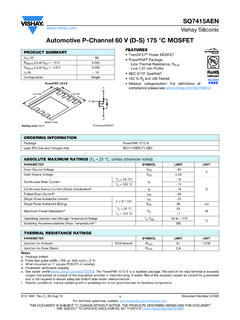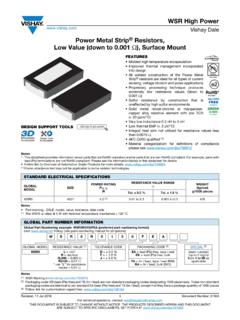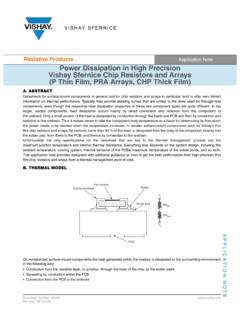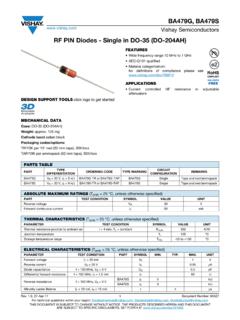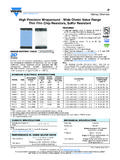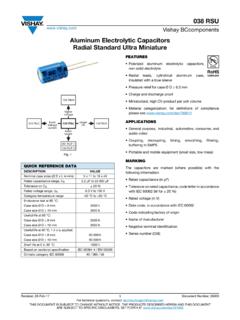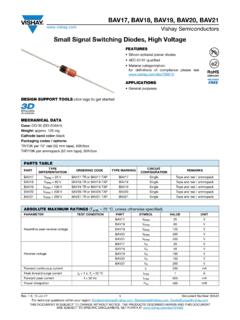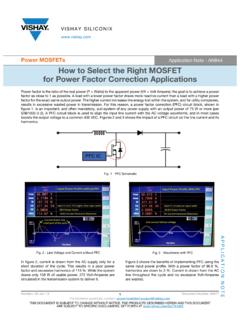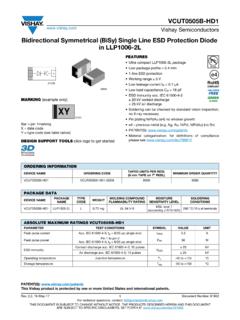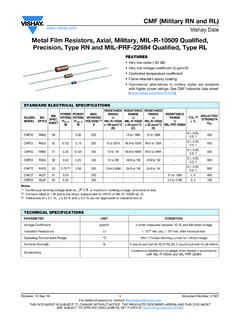Transcription of Current Measurement - Vishay Intertechnology
1 Vishay DALEP ower Metal Strip ResistorsTechnical NoteComponents and Methods for Current Revision: 31-Aug-151 Document Number: 30304 For technical questions, contact: DOCUMENT IS SUBJECT TO CHANGE WITHOUT NOTICE. THE PRODUCTS DESCRIBED HEREIN AND THIS DOCUMENTARE SUBJECT TO SPECIFIC DISCLAIMERS, SET FORTH AT NOTEBy Bryan YarboroughPURPOSEC urrent sensing is used to perform two essential circuit functions. First, it is used to measure how much Current is flowing in a circuit, which may be used for power management in a DC/DC power supply to determine essential peripheral loads to conserve power. The second function is to determine when it is too much, or a fault condition. If Current exceeds safe limits, then a software or hardware interlock condition is met and provides a signal to turn off the application, as in a motor stall or short circuit condition in a battery. It is essential to choose the appropriate technology with a robust design to properly withstand the extreme conditions that can exist during a fault.
2 The appropriate component performing the Measurement function would need to sustain an accurate voltage signal as well as prevent damage to the printed circuit METHODSA signal to indicate the how much condition and the too much condition is available in a variety of different Measurement methods, as listed below:1. Resistive (direct)a. Current sense resistors2. magnetic (indirect)a. Current transformerb. Rogowski coilc. Hall effect device3. Transistor (direct)a. RDS(ON)b. Ratio-metricEach has advantages that make it an effective or acceptable method for Current Measurement , but also has tradeoffs that can be critical to the end reliability of the application. They can also be classified into two main categories of Measurement methods: direct or indirect. The direct method means that it is connected directly in the circuit being measured and that the Measurement components are exposed to the line voltage, whereas the indirect method provides isolation that may be necessary for design ResistiveCurrent Sense ResistorThe resistor is a direct method of Current Measurement that has the benefit of simplicity and linearity.
3 The Current sense resistor is placed in line with the Current being measured and the resultant Current flow causes a small amount of power to be converted into heat. This power conversion is what provides the voltage signal. Other than the favorable characteristics of simplicity and linearity, the Current sense resistor is a cost-effective solution with a stable temperature coefficient of resistance (TCR) of < 100 ppm/ C or %/ C and does not suffer the potential of avalanche multiplication or thermal runaway. Additionally, low-resistance (< 1 m is available) metal alloy Current sense products offer superior surge performance for reliable protection during short circuit and overcurrent and Methods for Current MeasurementTechnical DaleTECHNICAL NOTE Revision: 31-Aug-152 Document Number: 30304 For technical questions, contact: DOCUMENT IS SUBJECT TO CHANGE WITHOUT NOTICE. THE PRODUCTS DESCRIBED HEREIN AND THIS DOCUMENTARE SUBJECT TO SPECIFIC DISCLAIMERS, SET FORTH AT MagneticCurrent TransformerA Current transformer (Fig.)
4 1) provides three key advantages: isolation from line voltage; lossless Current Measurement ; and a large signal voltage that can provide noise immunity. This indirect Current Measurement method requires a changing Current - such as an AC, transient Current , or switched DC - to provide a changing magnetic field that is magnetically coupled into the secondary windings. The secondary Measurement voltage can be scaled according to the turns ratio between the primary and secondary windings. This Measurement method is considered lossless because the circuit Current passes through the copper windings with very little resistive losses (Fig. 2). However, a small amount of power is lost due to transformer losses from the burden resistor, core losses, and primary and secondary DC 1 - Ideal Current transformer circuitFig. 2 - Current transformer loss componentsRogowski CoilThe Rogowski coil (Fig. 3) is similar to a Current transformer in that a voltage is induced into a secondary coil that is proportional to the Current flow through an isolated conductor.
5 The difference is that the Rogowski coil is an air core design as opposed to the Current transformer that relies upon a high-permeability core, such as a laminated steel, to magnetically couple to a secondary winding. The air core design has a lower inductance to provide a faster signal response and very linear signal voltage. Because of its design, it is often used as a temporary Current Measurement method on existing wiring such as a handheld meter. This could be considered a lower-cost alternative to the Current 3 I1:NRDCRRB urdenINV =INx RBurden()PRIDCRICoreRBurdonIInputRCoreLM agIMagITransformedN2 SECDCRN212M2t1 AIMTrim 1 Trim 2 HgndRejustoreeRS = 20 RogowskicoilRj11 k Rj25 k ZinVinIntegratorAmplifierVout (t) = 1/ Vin16-QFN4 mm x 4 mm(a)Power ampGeneratorAcCoil under testReference coilRloadAnalog inputmoduleSwitchAC amplifier(b)ZinRfRfLP filterCfComponents and Methods for Current MeasurementTechnical DaleTECHNICAL NOTE Revision: 31-Aug-153 Document Number: 30304 For technical questions, contact: DOCUMENT IS SUBJECT TO CHANGE WITHOUT NOTICE.
6 THE PRODUCTS DESCRIBED HEREIN AND THIS DOCUMENTARE SUBJECT TO SPECIFIC DISCLAIMERS, SET FORTH AT EffectWhen a Current -carrying conductor is placed in a magnetic field (Fig. 4), a difference in potential occurs perpendicular to the magnetic field and the direction of Current flow. This potential is proportional to the magnitude of the Current flow. When there is no magnetic field and Current flow exists, then there is no difference in potential. However, when a magnetic field and Current flow exist, the charges interact with the magnetic field causing the Current distribution to change, which creates the hall voltage (Fig. 5).The advantage of hall effect devices is that they are capable of measuring large currents with low power dissipation. However, there are numerous drawbacks that can limit their use, such as non-linear temperature drift requiring compensation, limited bandwidth, low-range Current detection requiring a large offset voltage that can lead to error, susceptibility to external magnetic fields, ESD sensitivity, and high 4 - Hall effect principle, no magnetic fieldFig.
7 5 - Hall effect principle, magnetic field present3. TransistorRDS(ON) - Drain-to-Source On-ResistanceTransistors are considered a lossless overcurrent detection method since they are standard control components to the circuit design and no further resistance or power dissipating devices are required to provide a control signal. Transistor datasheets provide the on-resistance for the drain-to-source (RDS(ON)) with a typical resistance in the m range for power MOSFETs. This resistance consists of several components that begin with the leads (Fig. 6) connecting to the semiconductor die through the resistance that makes up the numerous channel characteristics. Based on this information, the Current passing through the MOSFET can be determined by ILoad = VRDS(ON) / RDS(ON).Each constituent of the RDS(ON) contributes to Measurement errors that are due to minor variations in the resistances of the interface regions and TCR effects. The TCR effects can be partially compensated by measuring temperature and correcting the measured voltage with anticipated changes in resistance due to temperature.
8 Often times the TCR for MOSFETs can be as large as 4000 ppm/ C, which is equivalent to a 40 % change in resistance for a 100 C rise. Generally, this Measurement method provides a signal with approximately 10 % to 20 % accuracy. Depending on the accuracy requirements, this may be an acceptable range for providing overcurrent 6 - Simple model of an n-channel enhancement type MOSFETIV = 0 IVH = VBLoadMetalSi02VS++VGSIDDGGatePSNN+N+IDV DSD rainSourceVGSC omponents and Methods for Current MeasurementTechnical DaleTECHNICAL NOTE Revision: 31-Aug-154 Document Number: 30304 For technical questions, contact: DOCUMENT IS SUBJECT TO CHANGE WITHOUT NOTICE. THE PRODUCTS DESCRIBED HEREIN AND THIS DOCUMENTARE SUBJECT TO SPECIFIC DISCLAIMERS, SET FORTH AT Metric - Current Sense MOSFETsThe MOSFET consists of thousands of parallel transistor cells that reduce the on-resistance. The Current sensing MOSFET uses a small portion of the parallel cells and connects to the common gate and drain, but a separate source (Fig.)
9 7). This creates a second isolated transistor; a sense transistor. When the transistor is turned on, the Current through the sense transistor will be a ratio comparable to the main Current through the other on the transistor product, the accuracy tolerance range can vary from as low as 5 % to as wide as 15 % or 20 %. This is generally not suitable for Current control applications that typically require 1 % Measurement accuracy, but is intended for overcurrent and short circuit 7 4. Resistor Technology OptionsResistor TechnologiesI will begin the explanation of the impact of resistive technology with the least robust technology for Current sense applications and progress through to the most robust Film: These devices are not typically used for Current sense applications, but are included in this discussion to provide breadth to the topic. Generally these resistive products are for precision applications because of their resistive layer ranges from " to " thick.
10 They are quite surge-tolerant in the appropriate application, but are not designed for the high currents typically associated with the applications mentioned in this METHODACCURACYISOLATIONEMI (TAMPER RESISTANCE)ROBUSTSIZECOSTRESISTIVE (DIRECT)Sense resistorHighNoHighHighSmallLowTRANSISTOR (DIRECT)RDS(ON)LowNoModerateModerateSmal lLowRatio metricModerateNoModerateModerateSmallMod erateMAGNETIC (INDIRECT) Current TransformerHighYesModerateHighLargeModer ateRogowski coilHighYesModerateHighLargeModerateHall effectHighYesHighModerateModerateHighGat e DriveVBATLoadISENSEIsfVSENSERSENSER1R2 KELVIN /SOURCEOUT+-VOUTP ower GroundIsf = SenseFET CurrentComponents and Methods for Current MeasurementTechnical DaleTECHNICAL NOTE Revision: 31-Aug-155 Document Number: 30304 For technical questions, contact: DOCUMENT IS SUBJECT TO CHANGE WITHOUT NOTICE. THE PRODUCTS DESCRIBED HEREIN AND THIS DOCUMENTARE SUBJECT TO SPECIFIC DISCLAIMERS, SET FORTH AT Thick Film Resistor Products: The RCWE and RCWL are typically " to " thick, which is nearly 100 times that of thin film.
